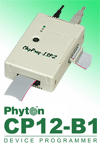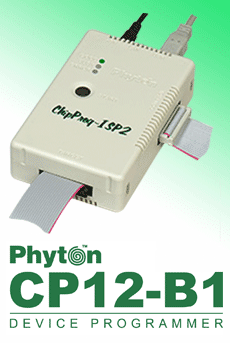 |
| |
Phyton CP12-B1 - In-System Device Programmer |
|
|
|
|
|
| |
The CPI2-B1 device programmer belongs to the ChipProg-ISP2 family of Phyton in-system production device programmers, designed for use with ATE, ICT, programming fixtures and automated handlers. It can also be used for development, and in stand-alone mode for field service. CPI2-B1 can be used for programming microcontrollers, flash memory and programmable logical devices.
Use of some CPI2-B1 programming features requires purchasing additional software licenses:

The CPI2-ACI license is tied to the programmer's hardware and enables remote control via DLL and other options.

CPI2-D-XXXX target-specific Device Driver Library licenses enable programming support for a certain group of devices.
|
| |
|
|
 |
Major Features |
|
- Designed around extremely fast CPI2 programming engine - see the timing.
-
Connects to PC via High Speed USB 2.0, 100 Mbit/s Ethernet or RS232 (optional) interfaces.
-
Stand-alone or PC-hosted operation.
-
Has a SD card for storing up to 64 projects
-
Use of the SD card enables fast project switching and speeds up stand-alone operations.
-
Up to 72 programmers can be concurrently controlled by a single PC.
-
Supports multiple ISP interfaces: JTAG, JTAG chain, SWD, SPI, SCI, I2C, UART, and more.
-
Supports ISP for devices with Vcc voltages in the range of 1.2V to 5.5V.
-
Programmable Vpp power supply output from 1.5V to 15V.
-
Power source for target board adjustable from 1.2 to 5.5V @ 350 mA.
-
Programs devices at distances as long as 10 ft (3m) - actual distance is target specific.
|
 |
Areas of Application |
|
- Production single and multi-channel device programmer for use in ATE, ICT, fixtures and handlers.
-
Development in-system device programmer.
-
Stand-alone battery-powered in-field service programmer.
|
 |
Implementations and Mechanical Options |
|
- Palm-size unit in a plastic enclosure.
-
Includes removable plastic bracket for mounting CPI2-B1 units on a standard 35 mm DIN rail.
-
An optional small compartment with a lithium battery and controls can be attached to the CPI2-B1 unit for stand-alone operation such as in-field service.
|
 |
Communication Interfaces |
|
- High Speed USB 2.0 (480Mbps).
-
100 Mbit/s Ethernet with ATE-to-DUT galvanic insulation.
-
RS-232C, galvanically isolated (optional, requires CPI2-ISO board).
|
 |
Control Methods |
|
- Friendly and intuitive graphical user interface (GUI).
-
User-configurable simplified interface for use by unskilled personnel.
-
Integration with National Instruments® LabVIEW™ software.
-
Controllable by Automated Test Equipment (ATE), In-Circuit Test System (ICT), fixtures and handlers.
-
Application Control Interface (DLL).
-
Command line mode.
-
On-the-fly control utility allows modification of commands in a running programmer without stopping its operation.
-
Script language for mastering user-defined scripts.
-
Programming can be initiated manually or automatically by connecting to target device or closing the fixture lid.
|
 |
Project and Configuration Management |
|
 |
Power Source Options |
|
- External power adapter 5V@1A.
-
Can be powered by PC's USB communication port.
-
Rechargeable Li-Ion battery (optional).
|
 |
Power for Targets |
|
- In a process of programming allows powering target equipment from external sources.
-
When powered from an external power adapter (5V@1A), CPI2-B1 can provide Vcc (1.2 to 5.5V @ up to 350mA) and Vpp (1.2 to 15V @ up to 80mA) voltages for the target equipment.
|
 |
Software Features |
|
- Supports loading and saving files in all popular formats.
-
Unlimited number of data buffers can be open simultaneously.
-
Arithmetic operations on data blocks in buffers.
-
Programmable serialization of target devices.
-
Multiple serialization algorithms, including script-controlled ones.
-
Allows writing of user-defined signatures and data blocks into target devices.
-
Several different algorithms of checksum calculation.
-
Special DLL for user-defined checksum calculation.
-
Stores logs of programming sessions with time-stamping.
-
Easy to use GUI editor for device-specific settings and algorithm parameters, such as fuses, lock bits, protected sectors, boot loader vectors, clock frequency, etc.
-
Featured with a link opening connection diagram for currently selected device right from the GUI.
-
Comprehensive self-test and diagnostic procedures.
|
 |
Target Interface Signals |
|
- Equipped with a 20-pin "TARGET" connector and supplied with a 10" ribbon cable with compatible 20-pin headers.
-
Ten target-specific logic inputs/outputs with 1.2 to 5.5V levels, individually programmable as I/O, GND or Vcc.
-
For stable programming the above ten signal lines are interspersed with GND wires.
-
Two inputs/outputs individually programmable as TTL logic I/O, GND, or Vcc or Vpp.
|
 |
Signals for Interfacing with External Equipment |
|
|
TTL-level input and output logic signals for interfacing with external equipment are available at the 20-pin "CONTROL" connector.
The signals include:
- start/stop signal;
- output status signals: BUSY, GOOD and ERROR;
- six inputs for selection of one of the 64 pre-loaded projects;
- one low-current TTL logic voltage output that can be used for driving the above project selection inputs;
- three GND lines.
- Use of CPI2-ISO board insures galvanic isolation of all control signals on the "CONTROL" connector.
- When using CPI2-BB option, the connector provides power for charging the battery but other "CONTROL" signals become unavailable for use.
|
 |
System requirements |
|
- Microsoft® Windows™ XP, 7, 8 and 10.
|
| |
 |
Phyton CP12-B1 - In-System Device Programmer
The CPI2-B1 device programmer belongs to the ChipProg-ISP2 family of Phyton in-system production device programmers, designed for use with ATE, ICT, programming fixtures and automated handlers.
Discontinued Product
|
This product has been discontinued. Please refer to the Replacement Product instead:
|  |


| Product Information |
| Phyton CP12-B1 - In-System Device Programmer |
| Phyton |
|
PHY-CP12-B1 |
| Discontinued Product |
|
|